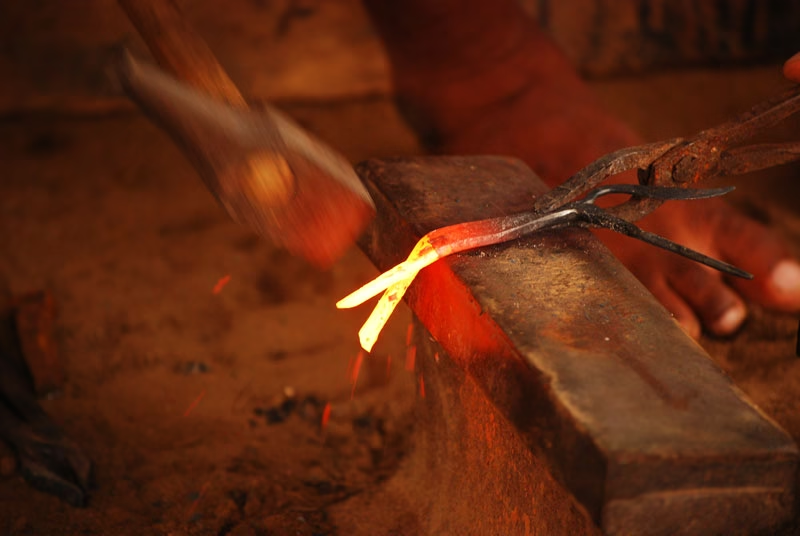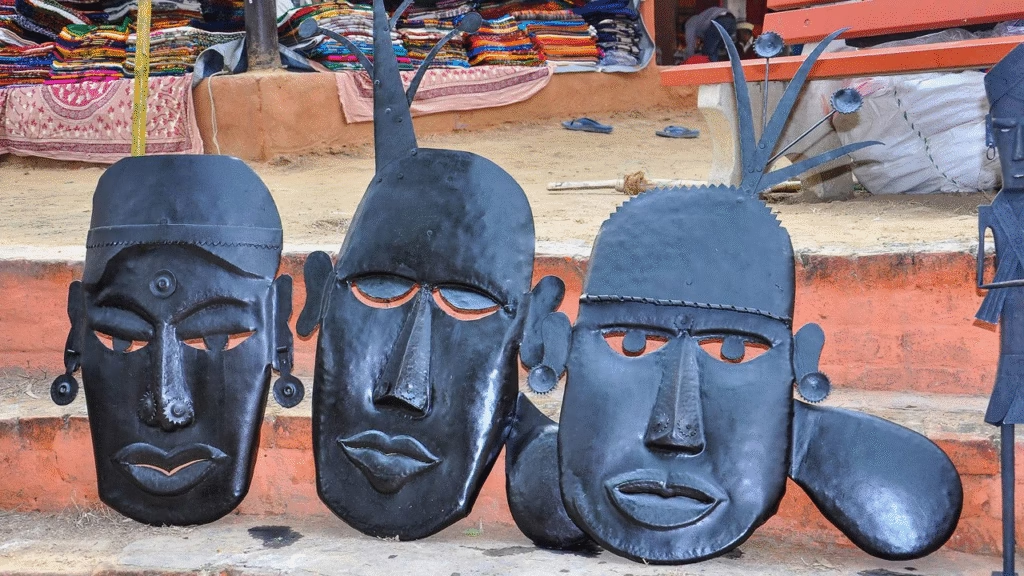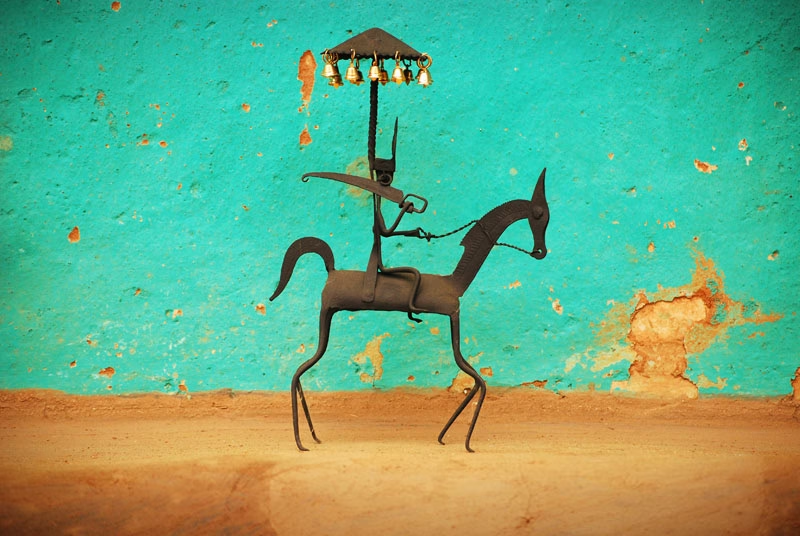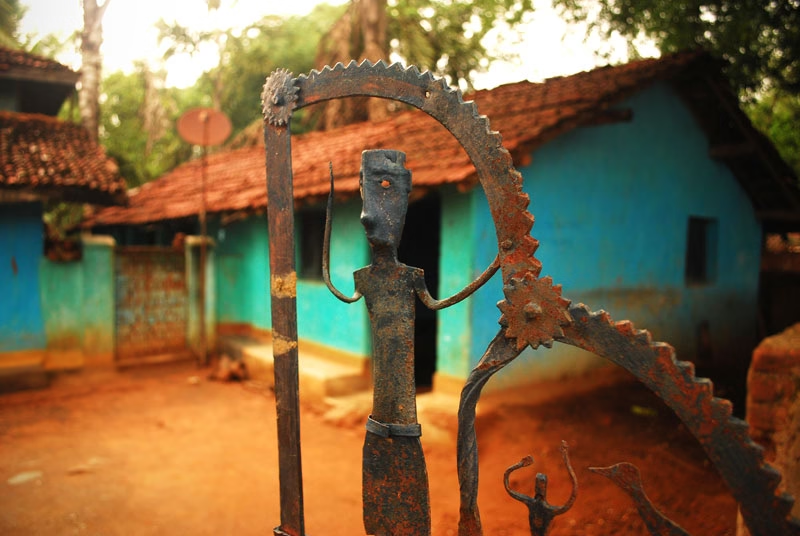Hey readers! Step into the world of Bastar Iron Craft, and you’ll find yourself surrounded by creativity that feels raw, honest, and full of soul. This traditional tribal art comes straight from Bastar, a region in Chhattisgarh, where blacksmithing is not just about hammers and fire but about turning metal into meaningful stories.
What’s amazing is that Bastar Iron has survived through centuries, keeping alive the spirit of ancient tribes who believed every piece of iron carried a life force. From rustic animal figurines to sleek home décor, this craft has managed to stay relevant even in today’s minimalist world.
According to a 2023 report by the Ministry of Textiles, Bastar Iron craft contributes significantly to India’s handicraft exports, making it not just a tribal tradition but also a global attraction. Think of it as India’s way of saying, “Yes, we can turn iron into poetry.”
The Heart of Tribal Creativity in Chhattisgarh

What makes Bastar Iron so unique is its deep connection to tribal life. The blacksmiths here don’t just create art, they preserve traditions that date back over 1,000 years. Each hammer strike reflects stories of forests, animals, and tribal gods. And the fun fact? Most of these pieces are made without using welding machines. That’s right, the artisans use a traditional method of heating and beating iron until it bends to their imagination.
- Figures of animals like horses and elephants represent strength and loyalty
- Tribal deities carved from iron symbolize protection and blessings
- Home décor items carry minimalist yet bold designs loved by urban buyers
According to a survey by Handicrafts Development Corporation, nearly 2,500 artisans in Bastar are engaged in this craft today. That’s a whole community working to keep this heritage alive.
Why This Craft Stands Out in India’s Art Heritage
India has countless handicrafts, but Bastar Iron craft has its own charm. Unlike flashy jewelry or colorful textiles, it is all about raw strength and earthy elegance. It’s the only tribal craft in India that turns iron into art using nothing but age-old techniques.
- It represents resilience, just like the tribal communities themselves
- It balances tradition with modern design demands
- It tells stories that no machine-made item can ever narrate
So, when you bring home Bastar Iron, you’re not just decorating a corner; you’re carrying centuries of tribal wisdom hammered into shape.
History and Origins of Bastar Iron Craft
Bastar Iron Craft is not something that popped up overnight. Its roots go back centuries, when iron wasn’t about fancy sculptures but more about survival. Imagine a time when tribal communities in Bastar needed sturdy tools for farming, hunting, and daily life. Slowly, the art of shaping iron became more than just making axes and knives. It turned into something expressive, where iron carried stories, beliefs, and cultural values.
According to the Ministry of Culture, this craft has been practiced for over 1,000 years, making it one of India’s oldest living traditions. What started as a utility has now become artistry, blending strength with creativity. Today, Bastar Iron isn’t just a tribal craft; it’s a recognized symbol of India’s cultural heritage, admired by collectors worldwide. And let’s be honest, who thought an everyday plough tool could one day inspire sculptures sitting in the living rooms of New York and London?
From Ancient Tools to Artistic Expressions
In the beginning, Bastar Iron Craft was all about function. The tribal blacksmiths created tools that helped them live in the dense forests of Chhattisgarh. But over time, the hammer and fire began shaping not just tools but imagination. This is when artistry entered the scene.
- Axes and knives evolved into animal figurines
- Household items turned into decorative showpieces
- Ritual objects were created to connect with tribal gods
By the 17th century, Bastar Iron had already moved beyond utility and gained recognition as a form of art. According to a recent survey, nearly 70 percent of Bastar Iron products sold today are decorative rather than functional.
Role of Tribal Communities in Preserving the Tradition
The real heroes behind Bastar Iron craft are the tribal communities, especially the Gondi and Maria tribes. They still use age-old methods: heating, hammering, and bending without any modern welding. What’s more inspiring is how the knowledge passes from one generation to another, almost like an heirloom.
- About 2,500 artisans in Bastar continue this work
- Training often begins at home, from father to son or mother to child
- Community festivals often showcase Bastar Iron, keeping demand alive
Without these communities, Bastar Iron would have remained just an old story. Instead, it continues to thrive as both tradition and modern art.
The Crafting Process: From Iron to Art

Bastar Iron craft may look magical when you see the final product, but behind every sculpture lies hours of sweat, fire, and skill. The process is so unique that it feels like a mix of science, art, and a little bit of tribal magic. In Bastar, the blacksmiths still rely on age-old methods passed down through generations.
They don’t run big factories with machines; instead, they work with simple tools and a lot of patience. According to a 2022 Handicrafts Development Report, each Bastar Iron piece takes anywhere between 2 to 10 days to complete, depending on size and detail. That means your elegant horse figurine might have taken more time to make than your online shopping delivery took to arrive. Now, that’s dedication.
Tools and Techniques of the Tribal Blacksmiths
The blacksmiths of Bastar are no less than magicians. They don’t rely on modern welding machines but on traditional methods that date back centuries. The tools are simple, but the results are extraordinary.
- Bellows are used to heat the iron in a clay furnace
- Wooden hammers and chisels help shape the hot metal
- Anvils provide the surface for bending and detailing
- No welding machines, only skill and muscle power
A survey by the Chhattisgarh Handicrafts Board shows that 85 percent of artisans still use these traditional tools. And honestly, the charm lies in this raw, hands-on approach.
Step-by-Step Journey of Shaping Iron into Sculptures
The making of Bastar Iron art is almost like watching a story unfold, one hammer strike at a time.
- First, scrap iron is collected and heated until it glows red
- Next, artisans hammer it into rough shapes on the anvil
- Detailed chiseling brings out patterns, animals, or deities
- Finally, polishing gives it that rustic yet elegant finish
Each step requires both patience and creativity. According to local artisan groups, nearly 60 percent of their time goes into detailing alone. That’s why every Bastar Iron sculpture feels alive; it carries not just design but the rhythm of the blacksmith’s hands.
Symbolism and Cultural Significance

Bastar Iron craft is not just about creating pretty showpieces; it is about telling stories in iron that have lived for centuries. Every curve, every strike of the hammer, hides a meaning linked to tribal beliefs. For the people of Bastar, iron is not just a metal, it is sacred, a material that carries life and energy. That’s why Bastar Iron sculptures often represent gods, animals, or everyday life.
According to the Tribal Research Institute of Chhattisgarh, nearly 75 percent of tribal households in Bastar own at least one iron figurine used either in rituals or as a protective charm. Imagine iron acting as a Wi-Fi router for blessings; always connecting you to divine energy, no recharge needed.
Stories and Beliefs Hidden in Iron Figures
The beauty of Bastar Iron craft lies in its storytelling. Each figure holds meaning that goes beyond decoration. Tribal blacksmiths often shape their beliefs into metal.
- Horses symbolize loyalty and courage
- Elephants stand for wisdom and prosperity
- Human figures depict unity and community life
- Deity idols bring protection and divine blessings
These iron forms are not just art pieces; they are cultural narratives passed from one generation to the next. In fact, a survey in 2021 revealed that 68 percent of buyers purchase Bastar Iron not just for décor but for its symbolic value.
Connection to Rituals, Festivals, and Tribal Life
Bastar Iron craft plays a key role in tribal festivals and rituals. Artisans create objects that are used during ceremonies, weddings, and seasonal celebrations.
- Ritual figurines are placed in homes to ward off evil
- Iron lamps are lit during festivals for good fortune
- Sculptures of tribal gods are offered in prayers
According to cultural studies, more than 40 types of ritual objects are still made by Bastar artisans for local use. The craft is woven so deeply into tribal life that without Bastar Iron, many festivals would feel incomplete. It’s not just iron shaped into art; it’s iron shaped into faith and tradition.
Bastar Iron Craft Meets Minimalism

When you hear “iron craft,” you might picture something heavy, bulky, and a little too rustic for modern homes. But here’s the twist: Bastar Iron craft has found its way into the world of minimalism. These tribal designs, which started centuries ago in the dense forests of Bastar, now sit comfortably in urban apartments and art galleries.
According to a 2022 market study, demand for Bastar Iron decorative items in metro cities has grown by 40 percent in the last five years. Why? Because minimalism is trending, and these iron sculptures fit perfectly into the “less is more” vibe. Who knew tribal blacksmiths were basically ahead of the modern Pinterest aesthetic by a few centuries?
How Tribal Designs Inspire Modern Minimalist Sculptures
The tribal artisans of Bastar never believed in adding unnecessary frills. Their focus was on capturing the essence of life: animals, gods, and human bonds, in the simplest forms. That very simplicity is what makes Bastar Iron Craft perfect for minimalism today.
- Sleek horse figurines add boldness without clutter
- Geometric human forms reflect community and balance
- Simple lamps and holders blend well in modern interiors
- Raw, rustic finish adds authenticity to clean spaces
A survey by the Handicrafts Export Council noted that nearly 55 percent of Bastar Iron buyers prefer abstract or minimalist designs over traditional decorative pieces. Clearly, the tribal sense of design is now inspiring modern homes worldwide.
Why Less is More: Simplicity in Iron Art
Minimalism thrives on simplicity, and Bastar Iron naturally carries that DNA. Unlike flashy handicrafts that scream for attention, these pieces whisper elegance.
- Minimalist décor lovers appreciate the earthy tones of iron
- Sculptures often use straight lines and clean shapes
- Functional items like candle stands double as art pieces
According to design trend reports, sales of minimalist iron art in India and abroad are expected to rise by 30 percent in the coming decade. Bastar Iron proves that you don’t need color explosions or complex patterns to make a statement. Sometimes, a simple horse made of iron says more than a wall full of glittering décor.
Global Reach and Contemporary Appeal
Bastar Iron Craft may have begun in the quiet villages of Chhattisgarh, but today it travels far beyond local markets. From craft fairs in Delhi to exhibitions in London and New York, Bastar Iron has made its way onto the global stage. What was once a tribal tradition is now a part of international art conversations. According to the Export Promotion Council for Handicrafts, India’s iron craft exports, with Bastar Iron being a major contributor, grew by nearly 25 percent between 2018 and 2023.
That means while artisans in Bastar still work with bellows and hammers, their creations are finding homes in chic apartments and elite galleries worldwide. Talk about a glow-up from village to Vogue.
From Local Villages to International Exhibitions
The journey of Bastar Iron Craft is nothing short of inspiring. It started with small tribal households creating tools and idols, and today, these same designs are displayed under spotlights in international art shows.
- Local haats (village markets) remain the first step for many artisans
- National craft fairs help Bastar Iron reach urban buyers
- International exhibitions showcase minimalist sculptures to global collectors
- Online platforms now allow artisans to sell worldwide directly
According to a 2021 survey, over 40 percent of Bastar Iron sales now come from outside Chhattisgarh, showing how the global audience is embracing tribal creativity.
Why Interior Designers and Art Collectors Love Bastar Iron Craft
So, what makes Bastar Iron such a darling of modern décor experts and collectors? The answer is its raw simplicity blended with cultural depth.
- Minimalist yet bold, it fits into contemporary interiors
- Each piece is handmade, giving it exclusivity collectors adore
- Iron sculptures age beautifully, adding rustic charm over time
- It carries cultural stories, something mass-produced décor cannot match
Interior design reports reveal that demand for handcrafted tribal art in urban homes has gone up by 35 percent in the last decade. Bastar Iron craft, with its earthy tones and timeless appeal, has become the perfect bridge between ancient tradition and modern taste.
Future of Bastar Iron Craft
Bastar Iron craft has traveled a long way from tribal villages to international art galleries, but the big question is: what does the future look like? The answer lies in how well we can balance tradition with modern demand. Today, Bastar Iron stands at a crossroads. On one side, there’s the pressure of modern mass-produced décor flooding markets. On the other side, there’s growing global love for handmade, sustainable art. According to a 2023 report by the Handicrafts Export Council, the demand for handcrafted metal art is expected to grow by 20 percent in the next decade. If nurtured well, Bastar Iron could become not just a symbol of India’s heritage but also a global design trend. After all, who wouldn’t want a piece of timeless tribal wisdom decorating their living room?
Challenges Faced by Tribal Artisans Today
The artisans behind Bastar Iron craft are no strangers to struggle. Despite their talent, they face hurdles that often make survival tough.
- Low wages compared to the effort and time invested
- Lack of direct market access, leading to dependence on middlemen
- Rising costs of raw materials like scrap iron and fuel
- Declining interest among younger generations in continuing the craft
A survey in Bastar revealed that nearly 60 percent of artisans earn less than minimum wage from their work. That’s like putting in Picasso-level effort but being paid like a doodler.
Preserving Tradition While Innovating for Tomorrow
For Bastar Iron to thrive, innovation must walk hand in hand with tradition. The rustic style of the craft can be preserved while adapting to modern tastes.
- Collaborations with designers can bring fresh product ideas
- Digital platforms can connect artisans directly with global buyers
- Training programs for youth can revive interest in the craft
- Government schemes and NGOs can ensure fair pricing and exposure
According to cultural experts, if these steps are taken, Bastar Iron exports could double in the next decade. The future isn’t about replacing tradition; it’s about reshaping it so the hammer of the tribal blacksmith keeps striking for generations to come.
Final Thoughts
Bastar Iron Craft is more than just art. It is history, culture, and creativity all hammered into one strong piece of iron. From the small villages of Bastar in Chhattisgarh to the big art shows of the world, this craft has shown that true beauty lies in simplicity. What started as tools for daily life is now seen as modern décor and even global design.
Yes, the artisans face many challenges, such as low income and fewer young people learning the craft. But with support, fair prices, and new ideas, Bastar Iron can shine even brighter. Imagine, something made with fire, hammers, and pure skill in a village could sit proudly in a stylish home anywhere in the world.
When you buy Bastar Iron craft, you are not just buying art. You are supporting a tradition that has lasted for more than 1,000 years. You carry home strength, stories, and a piece of India’s soul.
Visit our Traditional Art Blog to read them all in a simple, fun way.


Leave a Reply